|
Muzzle Blasts Online |
|
...for the muzzleloading enthusiast |
|
The muzzleblasts.com domain, subdomains, content, etc., are neither affiliated with the NMLRA nor its paper magazine Muzzle Blasts |
|
Muzzle Blasts Online |
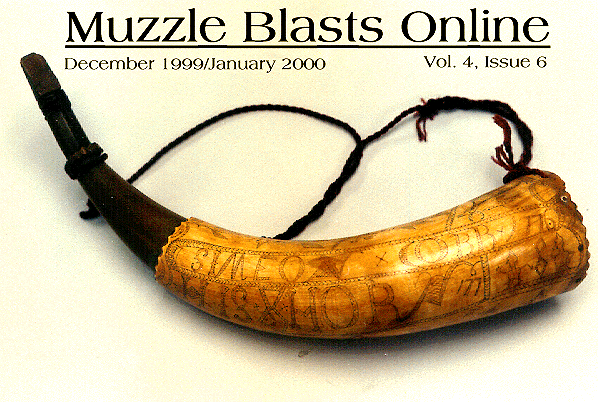
|
|
|
|
|
|
The Legacy of Simeon Cobb
Revolutionary War Soldier
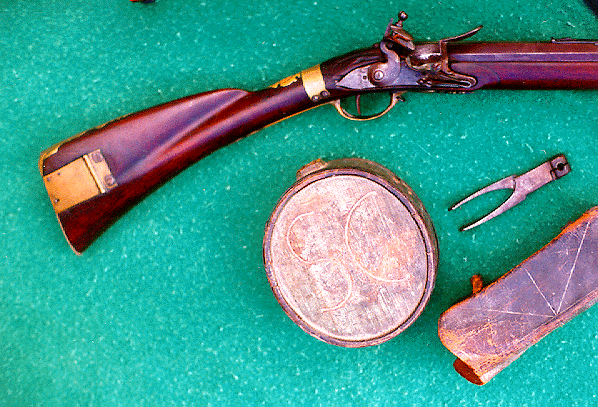
|
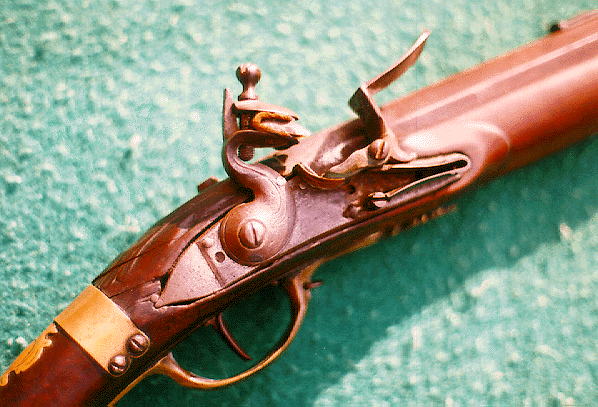
|
|
Discoveries included a very fine late-eighteenth-century rifle in exceptionally good condition and a wooden canteen. |
|
Simeon Cobb's gravestone provides a tantalizing synopsis of his eventful life, rendered in beautifully chiseled script: "In Memory of Simeon Cobb, Esq. Born in Taunton, Mass., who died Nov. 20 1843 AE 85 years 11 months 20 days. He served his country in various instances during the Revolutionary struggle and was two years a prisoner on board of a British man of war in the [West Indies]. He was a soldier of Stark, Gates, and Washington. His life was marked by a course of strict integrity and uprightness. He died rejoicing in hope of a blissful immortality."
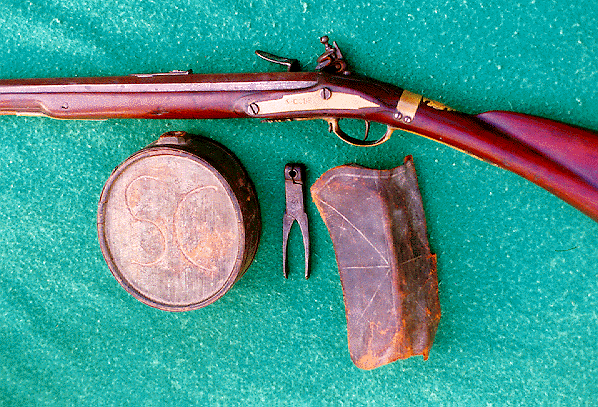
|

|
|
Cobb evidently treasured his belongings for all but the cartridge box bear hisname or initials. |
|
We can flesh out some details of Mr. Cobb's life with surviving documents. In 1832, at the age of seventy-four, Simeon applied for a pension for his service during the Revolution, and was granted an annual sum of $23.33 based on his rank and length of service. A deposition made by his brother Samuel, who was six years older, in support of Simeon's petition states the following:
...I worked at the Blacksmiths business...After the decease of my Father I was appointed Guardian of my Brother Simeon Cobb, who from that time worked with me as an apprentice to the trade of Blacksmith. During the apprentiship [sic] of the said Simeon Cobb some time in the year 1775 he enlisted as a Private Soldier in Captain Sophers Company in Colonel Walkers Regiment. He marched with the said company to Roxbury near Boston in Massachusetts, and served eight months and returned with said Company… In the month of June 1776 I removed to Westmoreland in the state of New-Hampshire [and] the said Simeon Cobb accompanied me …In the month of June 1776 at said Westmoreland the said Simeon Cobb enlisted as a Private Soldier in Captain Humphrey's Company of Winchester, New Hampshire. In Colonel Stark's or Colonel Wyman's Regiment I do not recollect which, … he marched with the Company to Ticonderoga and served five months and returned with the Company on the last day of November 1776… Some time in the summer 1777 the said Simeon Cobb enlisted at Chesterfield in the State of New-Hampshire for two months as a Private Soldier in Captain Carleton's Company in Genl. Stark's Brigade… The said Captain Carleton lived in Chesterfield, New Hampshire… The said Simeon Cobb marched with the Company to Charleston, N.H. thence to Manchester Vermont, and thence to Bennington Vermont… He served two months and returned with the company to Westmoreland and further I say not.
Simeon Cobb's own deposition provides even greater detail concerning the Revolutionary war service that he saw, presumably with some of the artifacts pictured with this article. The surviving court record declares: "That at the breaking out of the American revolution he resided at Taunton in the State of Massachusetts - that previous to the battle of Lexington he enlisted in a Company of minute men and on the first alarm that the British had left Boston in April 1775 he marched to Lexington in the company of Cap. Abiathan Leonard - was out fourteen days at that time.
That at said Taunton in the month of May 1775 he enlisted in the Massachusetts troops for the term of eight months in the Company of Cap. Oliver Soper in the Regt. of Col. Timothy Walker - was stationed at Roxbury near Boston near Roxbury Meeting house and served at said Roxbury until discharged about the first day of January 1776.
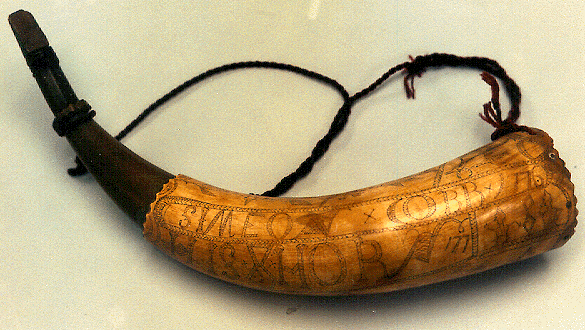
|
|
Simeon Cobb His Horn 1776. |
That at Westmoreland in the state of New Hampshire, to which place he removed in the month of June 1776, about the first of July 1776 he enlisted in the New Hampshire troops for the term of five months - he took the place of one Daniel Cobb who had been drafted for that term, in the Company of Capt. Humphrey and in the Regt. of Col. Stark, or Col. Wyman he cannot be confident which - marched by way of Rutland Vt to Mt. Independence on Lake Champlain - and there served the full term of his engagement - was engaged in building a fort and in building a floating bridge across the lake.
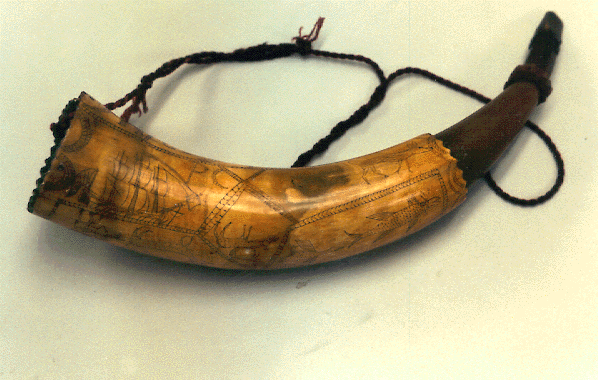
|
|
The horn bears the initials HG and many stylized figures. |
That at said Westmoreland in the month of May 1777 there was a call for the militia to go to defend Fort Ticonderoga - this declarant marched from said Westmoreland as far as Hubbardton Vt and there had orders to return - had got as far on their return as Charleston N.H. and there an express arrived requiring them to march back - marched a second time to Hubbardton Vt and arrived in the vicinity so that he heard the engagement at Hubbardton battle but did not arrive in season to engage. Was absent thirteen days on that tour in the Company of Capt. John Cole.
That at said Westmoreland in the month of July 1779 he enlisted for two months in the Company of Captain Carlton in the Regiment as he believes of Col. Wyman - marched to Bennington Vt, was in the battle of Bennington - then marched to Stillwater where he joined the troops of Gen. Gates and was there discharged at the end of his term.
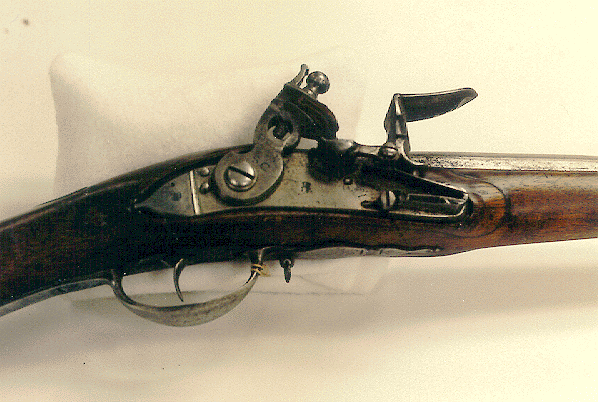
|
|
Simeon Cobb's Revolutionary War musket has a flat lock plate and double-throated cock, bridled pan, and molding around the lock mortise. |
That in the fall of 1777 he returned to Taunton Mass his former residence and in the month of February or March 1779 he enlisted in the Massachusetts troops for two months - took the place of one Philip Mason - was in the Company of Capt. Jacob Haskin - marched to Rhode Island by way of Tiverton - crossed at Howland's ferry and was stationed at the Quaker meeting house at Quaker hill - and there served the term of his engagement. " This deposition further explains that Simeon Cobb was born in Taunton on Nov. 28, 1757; he lived there fourteen years after the close of the war, and resided in St. Johnsbury, Vermont for the thirty-four years prior to the deposition. There is also an unclear reference to Cobb's shipping on Lake Champlain in 1776, when generals Gates and Arnold were there.
An additional deposition by Simeon Cobb documents his service at sea and capture by the British, as alluded to in the previously quoted gravestone inscription. It establishes that
...he sailed from Boston, Mass. in a Letter of Marque merchant vessel called the Caesar of about five
hundred tons burthen in the month of February, 1782. Said vessel was loaded with masts, spars, plank, etc,
and bound for Bordeaux in France - said vessel was commanded by Cap. Timothy Pierce of Bristol, R.I.
_______ Springer 1st mate - about three weeks after sailing from Boston they were captured by an English
Frigate of forty guns called the Ulysses and carried into Port Royal [illegible].
...Days after their arrival at that port the Count de Grasse was brought in. His ship the Ville de Paris and
other French ships, having been captured by Admiral Rodney - this Declarant shortly after his arrival at Port
Royal was put on board the British Frigate Acteon of forty guns commanded by Cap. Francis Perry. He had
enlisted as the armourer on board the Caesar and was compelled to serve in that capacity on board the Acteon
- was out in the Acteon three several cruises [sic] of about three months each and one of about a fortnight.
After hearing of the peace between Great Britain and the United States, he procured a letter to be addressed
to Admiral Rodney requesting his release, shortly after which he was released by Cap. Perry, which was about
the first of June 1783, having been detained a prisoner of war... fifteen months.
The Cobb musket also has sling swivels and finely fashioned hardware. August 16, 1777 marks the date of the Battle of Bennington. Immediately after his release he sailed in a hermaphrodite brig... to Charleston, South Carolina and from
thence took passage for Salem, Mass. At which latter place he arrived the latter part of June 1783.
The declarant further states that in his service at Roxbury in the summer of 1775 he [illegible] to the first
lieutenant of the Company who bore the same name as this applicant - the Lieut. Col. was Nathaniel Leonard.
That in his service at Mt. Independence in the summer of 1776 ______ Beldin was the Ensign of the
company and _______ Whipple was 2d Lieut.
That at the time of his two months service in 1777 Amos Pierce was the first Lieutenant, ______ Houghton
2d Lieu., Ensign Hastings.
That in his service at Rhode Island in 1779 he was never embodied in any Regt. And had no Colonel.
This document concludes with supporting evidence from three townsmen who knew Cobb, and even the
judge of the probate court lent his credence to Cobb's story. All testified that they had known Cobb for twenty
or more years and had often heard him speak of his Revolutionary service and imprisonment, even before the
pension law of 1818 was passed. I have chosen to quote extensively from the relevant documents because they
are a fascinating window on the life of Mr. Cobb, and because they are indicative of the type of useful
documentation that still may turn up in this latter day - at least if the researcher is persistent and very
fortunate.
The rifle pictured is of very fine quality, with moldings the length of the ramrod channel and around the
lock, lock escutcheon plate, and trigger guard. An adjustable rear step sight is present on the barrel. The forty-inch barrel is rifled with eight lands and grooves; it starts octagon and changes to round, with but the top flat
continuing all the way to the muzzle. The breech of the barrel is an inch and a quarter across; a taper reduces
the outside diameter to 13/16 at the muzzle. This is quite a sturdy and hefty firearm, evidently made for a man
of considerable stature and strength. Balls cast in the accompanying mold mike out at .549; the present owner
of the rifle reported that he and his brothers shot the rifle when they were youngsters in the nineteen-sixties.
The hand-made lock has a flat plate and rounded cock; it is made with a bridle on the pan and the tumbler.
The ramrod, if not original, is at least very old; it retains a worm on the end that slides into the stock. The
stock, which appears to be of cherry, was broken at the wrist and repaired with a brass band screwed to the
surface. The simple two-piece patch box covers a partitioned compartment; one section contains what may
be remnants of tallow or other patch lubricant. The trigger-reach distance is thirteen and three-quarters
inches, and the stock is one and 15/16 thick at the butt plate. The rifle's side plate is inscribed "S.Cobb"; the
mold and canteen bear the initials SC. The rifle stock is also stamped with the name A.Peck in two locations.
The canteen bears much of its original green paint and is so well preserved that it might yet hold water.
The cartridge box has provision for twenty-four rolled paper cartridges. The bullet mold is very nicely made,
though without sprue cutter, and in perfect repair. The unidentified cask, which I speculate was used for rum,
has suffered some rodent damage, but is in otherwise good condition; like the other treasured possessions, it
is identified with the owner's name.
When I learned that Cobb had spent some time at Roxbury camp outside Boston in 1775, I regretted even
more acutely the fact that his powder horn is not part of the present collection. It is known that Jacob Gay and
some other highly esteemed powder horn makers were actively at work in the camps around Roxbury, and
I couldn't avoid speculation that Cobb might have bought himself a good horn. Stephen Grancsay's book The
American Engraved Powder Horn tells us that horn No. 195, as documented by Rufus Grider in the nineteenth
century, bears the inscription "Simeon Cobb his horn 1776"; it has long been housed at the Fairbanks
Museum of Natural History in St. Johnsbury, Vermont. While it is not on display, the helpful curators at the
museum located the horn in question and invited me to have a look. In addition, they located Cobb's fine
smoothbore militia-style musket and a second powder horn. The latter is dated 1833, when Cobb was seventy-five years old, and it's of minor interest in comparison to the other artifacts. But the musket and exceptional
powder horn are worthy of inclusion here. I'm impressed by the fact that Simeon Cobb owned two long guns
and two horns that we know of, in an age when many folks were fortunate to own one of each. He, like us,
must have had a deep appreciation for these tools, as indicated by his fine taste, the expense he obviously
incurred in acquiring the best, and in marking every cherished object with his name and initials. His musket
is so marked on the stock, butt plate tang, side plate, and cock.
The musket has a forty-six-inch barrel of typically large caliber (.69?). It is held to the stock, which appears
to be good quality walnut, by three spring-retained barrel bands, and it has a bayonet lug. The musket is
equipped with sling swivels placed for carrying muzzle-up. The frizzen shows some wear, and the flash hole
appears very large. The large banana-shaped lock plate looks rather Germanic; mechanically, the piece seems
to be in perfect repair (but the curator declined my offer to take it outside for a few shots!). A copper heart-shaped thumb piece and a medallion inscribed "FUNDAMENTUM QUIETIS NOSTRAE (The Basis of Our
Peace) grace the stock. Peculiar, light, almost random line engraving covers many surfaces such as the side
plate and butt plate extension. One striking feature of the musket is the fact that the entire ramrod groove is
enclosed, as if drilled from the very tip of the fore end. The August 16, 1777 inscription on the stock marks
the date of the Battle of Bennington. Under the command of Col. John Stark, Cobb and his colleagues defeated
a combined force of Redcoats and Hessians in an engagement that's considered one of the turning points in
the Revolution. Might the twenty-year old soldier have carved his musket stock in camp that night, flushed
with victory and patriotic fervor?
Cobb's magnificent horn measures sixteen inches around the curve. The carrying strap is old, but probably
not original. The horn surface is entirely covered with deer, fish, birds in flight, a sailing ship, and at least
three human figures. Some of the motifs are suggestive of the work of Jacob Gay, but are not as finely
rendered. Jacob Gay's horns exhibit uneven quality, so perhaps the attribution can't be discounted.1 The horn
also bears the initials HG; perhaps they indicate the maker. In any case, this seems to be a fine example of
what's known as the Siege of Boston School of horn making.
We can thrill at these unspoiled, authentic artifacts that played a part in the formation of our country. It's
doubly exciting to learn more details about the man who used them. Though he is long gone, with proper care
his treasures will last forever, and his good fame will live yet a little longer. Part of the joy in unearthing facts
about Simeon Cobb is discovering what kind of man he was: an active, dedicated, intelligent patriot who
enjoyed a long and productive life. His good character is attested by multiple sources, and his lifelong integrity
is as useful an example to us as is his war service.
As complete and gratifying as this investigation has been, it could constitute merely a leg up to another
level of research. The probate court documents quoted above refer to nearly a dozen commanders under whom
Cobb served, and more inquiry into the history of specific units might yield further details about projects and
engagements that were part of Cobb's service. We are reminded by investigations such as this that it's
sometimes possible to put together a fairly complete package of documentation on surviving artifacts,
connecting them to individual owners. History seldom becomes more immediate or more exciting than this.
Footnote
Side bar:
If you own a powder horn, firearm, or other relic inscribed with the name of the maker or owner and wish
to research its history, there are several avenues to follow. Perhaps the most obvious one is to consult some
of the excellent specialized books available to lovers of history, old firearms, and accoutrements.
Another potentially fruitful source of information is the local historical society of the town where the
artifact or person originated. (I once experienced great success in documenting an antique powder horn I own
by following a nearly blind lead to a local historical society; the results of that research are documented in "A
Horn of Plenty" in the July, 1996 Muzzle Blasts.)
If the owner/maker in question served in the armed forces of our country, a record may be preserved in the
Military Service Records of the National Archives. You can write that office with as much known detail as
possible about the person, and if records exist you will get a report. You can get information and an order
form (NATF Form 80[7-84]) by writing to: Reference Services Branch (NNIR), National Archives and
Records Service, 8th and Pennsylvania Avenue, NW, Washington, DC 20408.
Some published family genealogies can provide useful information. Presumably the Internet could lead
researchers to such genealogies and other records concerning historic people. Finally, some town records and
histories of specific military units may provide additional information.
Rufus Grider (1817-1900), an art teacher whose study of engraved horns may never be exceeded in scope,
did detailed sketches of hundreds of antique horns. His drawings are in the archives of the New York
Historical Society Print Room (170 Central Park West, New York, NY 10024; 1-212-873-3400 [phone] or
212-787-9474 [fax]). If you seek information about one of the Grider horns, you will find the people at the
New York Historical Society to be friendly and helpful; I have dealt with them on two occasions. They can
supply photocopies or photographs of the original drawings. In the latter case, there is a charge of $40 for
an 8x10 print if a negative already exists, or $90 if the sketch has never before been photographed. There
is a fee for permission to use their material in a publication; contact the folks at the Historical Society for
further details. The horn inscribed "Simeon Cobb his horn 1776", designated as 195 in the Grider
collection is correctly attributed to the Fairbanks Museum in St. Johnsbury, Vermont by the entry in
Grancsay's American Engraved Powder Horns. However, an inexplicable discrepancy exists with this
horn, since the New York Historical Society archives contain no sketches of a Cobb horn. Latter-day
resources may not be infallible, but they still are extremely helpful; if you encounter a dead-end in your
research, try other avenues, for persistence pays off!

1 Guthman, William. Drums A'Beating, Trumpets Sounding (Hartford: Connecticut Historical Society,
1993), p. 25.